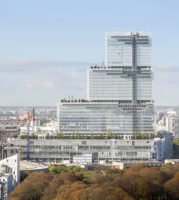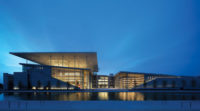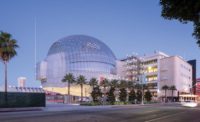With the new Whitney Museum of American Art, Renzo Piano Building Workshop (RPBW) bestowed lavish gifts on Manhattan, including a series of terraces overlooking the High Line, going far beyond the museum’s core programmatic needs. The firm does something similar with its Jerome L. Greene Science Center and neighboring Lenfest Center for the Arts, the first completed buildings at Columbia University’s Manhattanville Campus, a 17-acre site in Harlem, northwest of Columbia’s main Morningside Heights location. Greene contains laboratory space for neurological research; Lenfest, a stack of exhibition and performance venues. But both also make generous contributions to the neighborhood. Those include Greene’s lobby, which is open to the public seven days a week until 10 p.m. Handsomely appointed and generously proportioned, it bisects the building, leading straight through from its east-facing main entrance to a new plaza on its western side. That plaza is shared with Lenfest, which also contains public spaces, including the Miriam and Ira D. Wallach Art Gallery, relocated from a hard-to-find spot on Columbia’s main campus. (RPBW’s third Manhattanville building, a conference center called the University Forum, is already under construction immediately south of Greene, while its fourth, the Global Center, will rise west of Lenfest.) In providing the amenities that it promised the community when it announced the controversial expansion—its largest in more than 100 years—Columbia is off to a rip-roaring start.
Additional Information:
Jump to credits & specifications
The university hasn’t always used architecture so deftly. In the 1960s, its expansion plans, according to The New York Times, included “purchasing apartment buildings all over Morningside Heights, displacing thousands of poor, mostly black and Puerto Rican residents.” When it then attempted to build a gym in cityowned Morningside Park, anger erupted into riots, and the plan was dropped. In the decades that followed, the university turned inward. It commissioned I.M. Pei to design a master plan (1968–70) that included a pair of skyscrapers on the original McKim, Mead and White–designed Morningside Campus. A few years later (1974), it shoehorned the new Dodge fitness center by Eggers Partnership into the same crowded quadrangle. And in 1999, its student center, Lerner Hall, designed by then-architecture dean Bernard Tschumi, turned a forbidding face to busy Broadway.
This time, with the need for space especially pressing, Columbia couldn’t afford to alienate its neighbors. It won community support, or at least acquiescence, by offering sweeteners, including housing and a job-training program for residents. And it promised a campus that would welcome locals as well as students. True, the Greene Center, home to the Mortimer B. Zuckerman Mind Brain Behavior Institute, was hardly destined to become a neighborhood hangout. But, ingeniously, its ground floor houses a community wellness center, with mental health and stroke-prevention programs devised by Columbia physicians—thus bridging the gap between the work being performed inside the building and what’s happening around it. There is also a separate education center for local children.
Other promises were embodied in the campus master plan, by RPBW and Skidmore, Owings & Merrill: Columbia committed to keeping the cross streets through the Manhattanville campus open to traffic, and it promised to create a pedestrian thoroughfare running north–south from 125th to 133rd streets, connecting two new plazas—the one adjacent to Greene and Lenfest, and a larger one that will be flanked by a pair of business-school buildings designed by Diller Scofidio + Renfro in collaboration with FXFOWLE. Both Greene and Lenfest have upper levels that cantilever over their ground floors, in order, says Antoine Chaaya, the RPBW partner in charge of the projects, to maximize the width of sidewalks and the dimensions of plazas. In addition, Columbia put parking lots, mechanicals, and other back-of-house facilities underground, in what will ultimately be a 2 million-square-foot subterranean complex. That eliminated loading docks and many other street-level encumbrances.
Given the density of the complex, much hinges on the architecture. In recent years, RPBW has developed a kit of parts, used in projects as diverse as the Whitney, an ensemble of port buildings in Genoa, and the additions to the Los Angeles County Museum of Art. The parts include metal facade panels (often painted pale blue or gray); exposed structural elements (including diagonal bracing); cantilevered glass awnings; and red or orange accents. Here, the erector-set approach seems particularly apt. The campus is flanked by a subway viaduct to the east and an elevated highway to the west. “The soul of the site is industrial,” Chaaya observes.
Lenfest is by far the smaller, and simpler, of the two new buildings. An eight-story, 60,000-square- foot tower, its glass-walled lobby doubles as an exhibition space. “We are pretending that the plaza continues into the lobby,” Chaaya says of the ground floor’s transparent facades. Elevators—whose north and south shaft walls are clear glass at the lobby level, so as not to interrupt views through the building—ascend to a second-floor screening room/lecture hall and a forth-floor “black box theater.” Above that is the 20-foot tall, 3,600-square-foot Wallach Gallery, and a similarly proportioned top-floor gallery that boasts expansive skylights with exterior baffles. Because all the spaces may be used at the same time, a great deal of effort went into establishing acoustic separation, Chaaya says.
The larger Greene Center, at 450,000 square feet, also has an admirably clear parti. The roughly square building is divided into quadrants, with social spaces near the core and shared laboratories along the edges. Interior stairs connect workspaces and breakout areas, while exterior ones connect spacious terraces; the goal, as in many new research facilities, is to maximize opportunities for spontaneous interactions among scientists.
Extra structural supports were provided to shield sensitive brain-imaging equipment from building vibrations. Another challenge was bringing the sound of the subway, at 88 decibels, down to an acceptable 44 decibels, according to Chaaya. This was achieved by using a doubleglass skin for much of the exterior. In addition to providing acoustic insulation, the 16-inch channel between the glass layers reduces heating and cooling loads: air that has already circulated through the building is exhausted through this space, moderating indoor temperatures. It also brings a welcome layer of visual complexity—a kind of filigree—to what is otherwise a somewhat repetitive exterior.
When completed, the entire Manhattanville campus is expected to contain 6.8 million square feet of facilities on 17 acres, compared to a total of 5.6 million square feet on the 32 acres of the Morningside campus. That density, and the unavoidable newness of the buildings, could produce a kind of antiseptic office park on steroids rather than the inviting new neighborhood Columbia has promised. But with the architecture of the first two buildings, RPBW seems to have found a winning formula for blending town and gown.
CreditsJerome L. Greene Science Center Mortimer B. Zuckerman Mind Brain Behavior Institute Design: Renzo Piano Building Workshop in collaboration with Davis Brody Bond LLP and Body-Lawson Associates (New York)
Architect of record: Davis Brody Bond LLP and Body-Lawson Associates (New York)
RPBW Design Team: A. Chaaya (Partner in charge), S. Drouin (Associate), K. Doerr (Associate), R. Tse, with L. Coreth, E. Garnaoui, C. Ruiz, and W. Antozzi, F. Becchi, A. Belvedere (Partner), M. Busk-Petersen, E. Chassang, P. Colonna, N. Delevaux, A. Fritzlar, C. Issanchou, B. Malbaux, A. Saoud, T. Zamfirescu, J. Lim, K. Songkittipakdee, R. Subramanian; O. Aubert, C. Colson, Y. Kyrkos (models)
AOR Team: W. Paxson (Partner), J.M. Bond (Partner), D. Williams (Partner), J. Grant (Associate Partner), J. Henle (Associate Partner), E. Sparling (Associate Partner), J. Navarro (Sr. Associate), R. Gavilanes (Sr. Associate), J. Harrigan (Sr. Associates), N. Kershner (Sr. Associate), O. Sippl (Sr. Associate), A. Yu (Sr. Associate), D. Zhoung (Sr. Associate), J. Boon-Bordenave, E. Bramwell, C. Brown, M. Cardona, H.Y. Chan, R. DeVilla, B. Dole, J. Fukutomi, F. Gillis, T. Holland, B. Johnson, R. Kelly, M. Massay, C. Mattern, M. McConnell, A. McGee, V. Mitchell, D. Nicoulin, C. Paxson, V. Ross, M. Samara, J. Santos, M. Sarac, S. Traynor, G. Weiner
Associate Architect Team: V. Body-Lawson (Partner), A. Walker (Associate), A. Gladden, O. Prinzivalli
Consultants: WSP/Parsons Brinkerhoff (structure); Jaros, Baum & Bolles (MEP); Atelier Ten (sustainability); Jacobs Consultancy (laboratory consultant); VDA (vertical transportation); Arup (lighting), Mueser Rutledge (geotechnical engineering); James Corner Field Operations (landscape architect); IBA (façade); Davis Langdon (cost consultant); Stantec (civil engineer); Sam Schwartz Engineering (transportation engineer); Aggleton & Associates (security); WJE Engineers & Architects (waterproofing); Shen Milson & Wilke, Inc. (acoustics & vibration); SEA Consulting Inc. (material handling); Pentagram (graphics consultant)
General contractor: Landlease
Photographer: © Columbia University/Frank Oudeman © Columbia University/Nic Lehoux
Lenfest Center for the Arts Design: Renzo Piano Building Workshop in collaboration with AOR Davis Brody Bond LLP
Columbia Manhattanville Development Team: R. Kasdin (SEVP), J. Ienuso (EVP), D. Greenberg (EVP), P. Pitruzzello (SVP), M. Velez (VP), F. Gong (AVP), W. Elmes (AVP), M. Fletcher (AVP), S. Neissen (Director), J. Pepe (Director), D. Cole (Director), F. Giannelli, J. DeCesare, M. Chung, G. Wiener (AVP), R. Akovity, G. Duque
Associate Architect: Body Lawson Associates
Design Team: A. Chaaya (Partner in charge) with E. Garnaoui, K. Doerr (Associate), W. Antozzi, S. Drouin (Associate), C. Ruiz, A. Saoud,T. Zamfirescu and G. Glorialanza, C. Sun; O. Aubert, C. Colson, Y. Kyrkos (models)
AOR Team: W. Paxson (Partner), J.M. Bond (Partner), J. Henle (Associate Partner), J. Navarro (Sr. Associate), A. Yu (Sr. Associate), D. Zhoung (Sr. Associate), C. Brown, B. Johnson, Z. Kaung, C. Mattern, A. McGee, J. Paxson, A. Pesklevis, M. Sarac
Associate Architect Team: Victor Body-Lawson (Partner), A. Walker (Associate), A. Gladden, O. Prinzivalli
Consultants: WSP/Parsons Brinkerhoff (structure); Jaros Baum & Bolles (MEP); IBA (façade); James Corner Field Operations (landscape architect); Davis Langdon (cost consultant); VDA (vertical transportation); Arup (lighting, acoustical & vibration design); Fisher Dachs Associates (theater planning & design), Atelier Ten (sustainability); Mueser Rutledge (geotechnical engineer); Stantec (civil engineer); Aggleton & Associates (security); WJE Engineers & Architects (waterproofing); Simpson Gumpertz & Heger (codes); Pentagram (graphics consultant)
Photographer: © Columbia University/Frank Oudeman © Columbia University/Nic Lehoux
|
SpecificationsExterior Cladding: Metal panels: Enclos Corp. Metal/glass curtain wall: Glass: Interpane Curtain wall: Enclos Corp.
Roofing: Built-up roofing: Hydrotech Hot Applied Roof: Kemper Other: Terrace Pavers: Hanover
Glazing: Glass: Curtain Wall: Interpane
Doors: Entrances: Enclos Corp. Metal doors: Hollow Metal Doors: Long Island Fireproof Door Inc. Wood doors: Bauerschmidt & Sons Sliding doors: Profiler ICU-Trackless Sliding Doors: Horton Automatics FSFD-M Auto-set Fire Doors: Mckeon Firefighter D200E Fire and Smoke Rated Curtains: Mckeon Special doors: Clean Roll: Rytec
Hardware: Locksets: L Series Mortise Locks: Schlage Closers: LCN 4000 series: Allegion Exit devices: Von Duprin 98 Series: Allegion Other special hardware: LCN Automatic Operator:Allegion ED400 Automatix Operator: Dorma
Interior Finishes: Acoustical ceilings: Armstrong Suspension grid: Armstrong Demountable partitions: Unifor SPA Cabinetwork and custom woodwork: Bauerschmidt & sons, Inc. Paints and stains: intumescent paint: International Paint Paneling: Decoustics Solo Panel: Decoustics Saint Gobain Plastic laminate: Formica
Solid surfacing: Epoxy Countertops: Durcon Morritex flooring system: Sika Quartzite flooring system: Sika Purcem Flooring System: Sika Sikagard Descoglas: Sika Starsilent Acoustic Plaster: Pyrok Mosaic Wall Tile: Vitra Wall tiles: Tiles by Tina Capalbio Procelain Tile: Casalgrande Padana Basaltina-Linosa Porcelain Tile: Casalgrande Padana
Resilient flooring: Rubber tile 978 Smooth: Roppe Altro Walkway 20: Altro SDT: Armstrong
Carpet: Tretford Raised flooring: Haworth Custom GFRC: Ohio Cemtech
Furnishings: Office furniture: Steelcase Reception furniture: Steelcase Fixed seating: Vitra Chairs: Steelcase Tables: Steelcase Upholstery: Herman Miller, Vitra, Steelcase Other furniture: Exterior furniture by Knoll
Lighting: Interior ambient lighting: iGuzzini Downlights: USAI Tasklighting: Steelcase Exterior: iGuzzini Dimming system or other lighting controls: Digital Addressable Lighting Interface (DALI) by Lutron Electronics, Inc.
Conveyance: Elevators/escalators: Otis Accessibility provisions: Handi-lift
Plumbing: Acid Neutralization System: Burt Process Equipment Automated Animal Watering System: Edstrom Processed Vivarium & Laboratory Water Systems: HYDRO Medical Gas Compressed Air System: BeaconMedaes
Energy: Energy management or building automation system: Building Automation System:Siemens Desigo Building Automation System: TEC Systems Allen Bradley Factory Talk Energy Management System: TEC Systems Allen Bradley HMI SCADA Air Handling Units: Ventrol Chilled Beams: Trox Plate Frame Heat Exchange: Recuperator USA VAV Boxes: Anemosta |
















Post a comment to this article
Report Abusive Comment